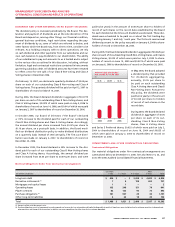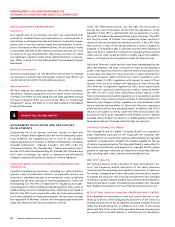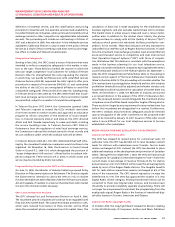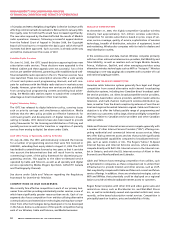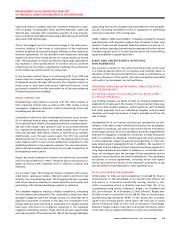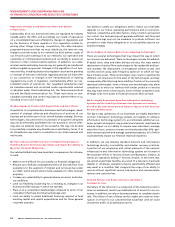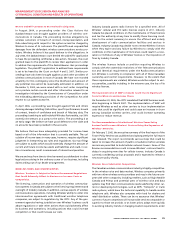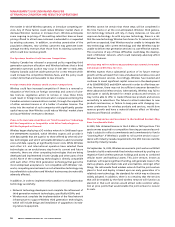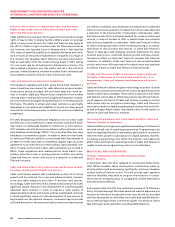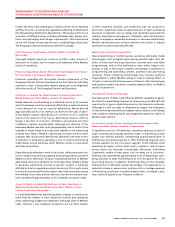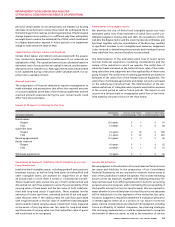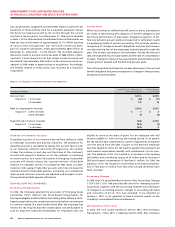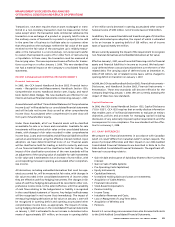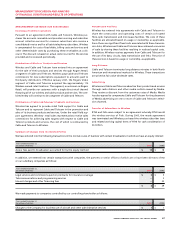Rogers 2006 Annual Report Download - page 61
Download and view the complete annual report
Please find page 61 of the 2006 Rogers annual report below. You can navigate through the pages in the report by either clicking on the pages listed below, or by using the keyword search tool below to find specific information within the annual report.
57
RO GER S CO MMU NIC AT ION S IN C . 20 0 6 ANN UA L RE POR T
MANAGEMENT’S DISCUSSION AND ANALYSIS
OF FINANCIAL CONDITION AND RESULTS OF OPERATIONS
Wireless is Depend ent on Certain Key Infrast ructure and Hand set
Vend ors, Which Could Impact the Q uality of Wireless’ Services or
Impede Net work Development and Expansion.
Wireless has relationships with a small number of essential network
infrastructure and handset vendors, over which it has no operational
or financial control and only limited influence in how the vendors
conduct their businesses. The failure of one of our network infra-
structure suppliers could delay programs to provide additional
network capacity or new capabilities and services across the business.
Handsets and network infrastructure suppliers may, among other
things, extend delivery times, raise prices and limit supply due to
their own shortages and business requirements. If these suppliers fail
to deliver products and services on a timely basis or fail to develop
and deliver handsets that satisfy Wireless’ customers’ demands, this
could have a negative impact on Wireless’ business, financial condi-
tion and results of operations. Similarly, interruptions in the supply
of equipment for our networks could impact the quality of Wireless’
service or impede network development and expansion.
Restrictions on the Use of Wireless Handset s While Driving May
Reduce Su bscriber Usage.
Certain provincial government bodies are considering legislation to
restrict or prohibit wireless handset usage while driving. Legislation
banning the use of hand-held phones while driving, while per-
mitting the use of hands-free devices, has been implemented in
Newfoundland. Legislation has been proposed in other jurisdictions
to restrict or prohibit the use of wireless handsets while driving
motor vehicles. Some studies have indicated that certain aspects of
using wireless handsets while driving may impair the attention of
drivers in various circumstances, making accidents more likely. Laws
prohibiting or restricting the use of wireless handsets while driving
could have the effect of reducing subscriber usage, which could
cause an adverse effect on Wireless’ business. Additionally, concerns
over the use of wireless handsets while driving could lead to litiga-
tion relating to accidents, deaths or bodily injuries, which could also
have an adverse effect on Wireless’ business.
Concerns about Radio Frequency Emissions May Adversely Af fect
Our Business.
Occasional media and other reports have highlighted alleged links
between radio frequency emissions from wireless handsets and vari-
ous health concerns, including cancer, and interference with various
medical devices, including hearing aids and pacemakers. While there
are no definitive reports or studies stating that such health issues
are directly attributable to radio frequency emissions, concerns over
radio frequency emissions may discourage the use of wireless hand-
sets or expose us to potential litigation. It is also possible that future
regulatory actions may result in the imposition of more restrictive
standards on radio frequency emissions from low powered devices
such as wireless handsets. Wireless is unable to predict the nature or
extent of any such potential restrictions.
CABLE AND TELECOM RISKS AND UNCERTAINTIES
Cable and Telecom’s Business Is Subject to Variou s Governmental
Regulations Whic h Could Adversely Affec t the Result s of
Operations.
Cable and Telecom’s operations are subject to governmental regu-
lations relating to, among other things, licencing, competition,
programming and foreign ownership. A significant percentage of
Cable and Telecom’s business activities is regulated by the CRTC under
the Telecommunications Act, the Radiocommunication Act and the
Broadcasting Act, and accordingly the results of operations are
affected by changes in regulations and decisions of the CRTC. Such
regulation relates to, among other things, licencing, competition,
the specific cable television programming services that Cable and
Telecom must distribute, as well as percentages of foreign owner-
ship and control of cable television licences. In addition, Cable and
Telecom’s CRTC licences must be renewed from time to time and
cannot be transferred without regulatory approval. The cable televi-
sion systems are also required to obtain certain authorizations and
to meet certain technical standards established by Industry Canada,
pursuant to its authority under the Telecommunications Act and
the Radiocommunication Act. Changes in regulation by the CRTC,
Industry Canada or any other regulatory body could adversely affect
Cable and Telecom’s business and results of operations. In addition,
the costs of providing any of Cable and Telecom’s services may be
increased from time to time as a result of compliance with industry
or legislative initiatives to address consumer protection concerns or
such Internet-related issues as copyright infringement, unsolicited
commercial e-mail, cyber-crime and lawful access.
Changes to the CRTC’s Regime for Local Telephone
Com petition Could Affec t Cable and Telecom’s Deliver y of Loc al
Telephone Ser vice.
The CRTC released its Local Forbearance Decision on April 6, 2006.
The decision was consistent with the assumptions made in the
business planning for Cable and Telecom’s local telephone service.
Canada’s incumbent telephone companies appealed the CRTC’s
Local Forbearance Decision to the Federal Cabinet. On December 11,
2006, the Minister of Industry announced a proposed decision in the
appeal of the CRTC’s forbearance decision. The proposed decision
would deregulate the incumbent phone companies once a facilities-
based competitor begins offering service. There would no longer be
any requirement for any market share loss before the incumbents
are deregulated in a market. Furthermore, the CRTC’s winback and
promotions safeguards would be removed upon promulgation of the
order, and the quality of service standards will be loosened. Comments
on the proposed order were received on January 15, 2007. Issuance of
this order will make it more difficult for Cable and Telecom’s local
telephone services to be established in the marketplace.
Cable and Telecom is Highly Dependent on Facilities and Ser vices
of the ILECs.
The telephony business is highly dependent on the availability of
unbundled facilities acquired from incumbent telecom operators,
pursuant to CRTC rules. On November 9, 2006 the CRTC commenced a
proceeding entitled Review of regulatory framework for wholesale
services and definition of essential service, in order to review these
rules. Changes to these rules could severely affect the cost of operat-
ing these businesses.


